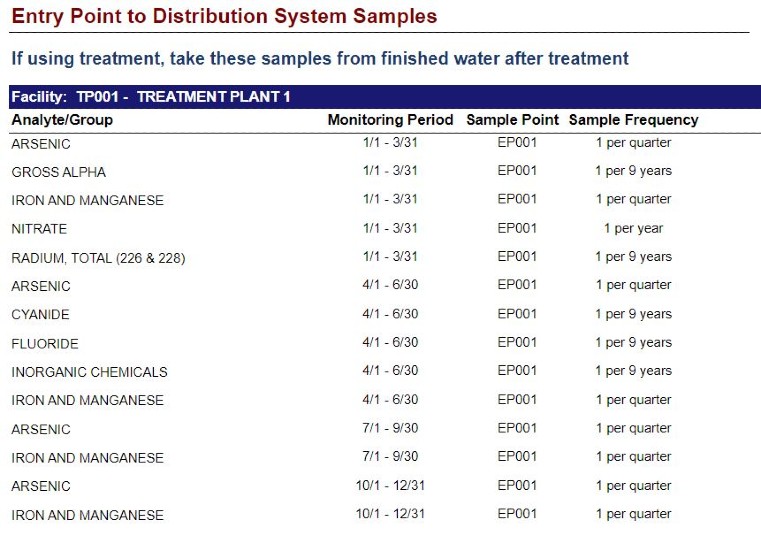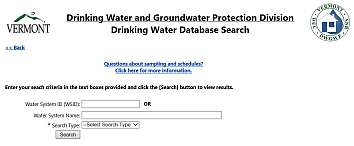Monitoring Schedules are provided on an annual basis by the Division, in mid-January. Schedules are not finalized until an official notification email is sent to the system's official contacts of record (Administrative Contact and Designated Operator). Once finalized, the current year schedule will no longer contain a red disclaimer message at the top that indicates an unofficial copy.
All public water systems are required to routinely monitor their drinking water for water quality. The frequency and timing of sampling is largely dependent upon the size and type of the water system. For convenience, the Division provides real-time, up-to-date monitoring schedules on the Drinking Water Database Search site.
The following codes help identify what your specific Facility IDs and Sample Point abbreviations mean on your monitoring schedule.
Facility IDs:
- WL = WELL/SPRING
- TP = TREATMENT PLANT
- DS = DISTRIBUTION SYSTEM
- IN = INTAKE (SURFACE WATER)
- ST = STORAGE TANK
- PF = PUMP FACILITY
- TM = TRANSMISSION MAIN
Sample Points:
- RW = RAW WATER
- EP = ENTRY POINT
- AS = ASBESTOS
- LC = LEAD AND COPPER
- TC = TOTAL COLIFORM
- HA = HALOACETIC ACIDS (DBP)
- TH = TRIHALOMETHANES (DBP)
Clicking on the specific analyte/group listed on your schedule will bring a pop-up list of all required analytes and analyte codes your certified laboratory needs to report the data electronically.
Alternatively, you may refer to the Chemical Groups Guidance Sheet for a list of individual contaminants required within the analyte groups shown on your monitoring schedule.
It is the responsibility of the water system to make sure sampling results are reported to the Division in a timely manner even if a lab offers electronic data submission. If results do not appear on the monitoring schedule website within two weeks of you receiving the results from the lab, forward a copy of your lab report to the Division using this email: ANR.DWData@vermont.gov.
If a required sample is not collected by the end of the monitoring period listed on your schedule (e.g., month, quarter, four-month period, six-month period, or calendar year), or if results are not received by the reporting deadline, the system will incur a violation. The violation results in the water system receiving a notice of alleged violation (NOAV) and requires the water system to distribute public notice to users for failure to monitor and/or report during the required period. If you have flexibility within the monitoring period, sample early so that you have sufficient time to resample if, for example, bottles are delayed or damaged in transit, or a sample is rejected by the lab.
Raw Water Monitoring
The Groundwater Rule requires groundwater systems to have a source sample tap installed before water treatment. Source water monitoring is required if total coliform is present in the distribution system (otherwise known as “triggered source monitoring” - TG). If you have not already done so, please ensure that your system installs a raw water sampling tap.
Finished Water Monitoring – Entry Point Chemicals such as IOCs, SOCs, VOCs, Radionuclides, and PFAS
Samples under the Phase II/V Rule (Chemical Contaminants), state PFAS regulation, and the Radionuclide Rule must be collected at the entry point to the distribution system (EPTDS). This sample point is located after all treatment (and storage), and prior to or at the first user/tap in distribution.
The most common Facility ID and Sample Point combination for a water system conducting entry point monitoring with one (1) entry point to distribution and one (1) treatment plant would be TP001/EP001. As water systems construct additional infrastructure and add sources and/or entry points, new IDs are created by Division staff and monitoring schedules updated accordingly.
Please note that testing for cyanide and radium are not performed directly by the Vermont Department of Health Lab. You must coordinate with your preferred lab to ensure samples are analyzed by a laboratory certified for the specific analyte and method required. Use the buttons below to navigate to the chemical monitoring page for more information and a list of certified laboratories.
Distribution System Monitoring (Total Coliform, Lead & Copper, Disinfection By-Products and Asbestos)
Total Coliform
Samples must be taken in the distribution system at locations previously approved in your current Bacteriological Sampling Plan. All public systems need to have an approved coliform sampling plan under the Revised Total Coliform Rule (RTCR). Visit the Revised Total Coliform Rule page using the button below for more resources pertaining to bacteria monitoring.
Lead & Copper
Samples must be taken in the distribution system at locations previously approved in your current Lead and Copper Sampling Plan. These locations are identified by the system as being most at risk for elevated levels of lead and copper. All distribution system lead and copper samples are taken as first-draw tap samples (with faucet strainers left in place) after the water has stood motionless in the plumbing system for at least 6 hours. Water systems are required to provide a copy of the lead and copper test results to all consumers whose homes/businesses were sampled (whether or not there was an exceedance) and comply with public education requirements when exceeding the lead action level (at the 90th percentile). All Public Community Water Systems must also include lead risk reduction language in their annual CCR. Visit the Lead and Copper Page using the button below for more resources pertaining regulation of lead and copper.
Disinfection By-Products (DBP) Monitoring
Public Community and Non-Transient Non-Community Water Systems which regularly, routinely, contain a chemical disinfectant (chlorine, chloramine, etc.) are required to conduct DBP monitoring for total trihalomethanes and the five regulated haloacetic acids at the time when the water contains the chemical disinfectant and in accordance with the water systems approved DBP sampling plan. This includes systems that use a chemical disinfectant annually during the summer months. This monitoring requirement does not apply when a system introduces a disinfectant under a defined emergency condition for a short duration of time: generally 60 days or less. Visit the DBP page using the button below for more resources pertaining to the regulation on DBPs.
Asbestos Monitoring
Asbestos contamination is the result of using asbestos cement (also known as "transite" or "ac") pipes whereby the fibers of asbestos in the pipes degrade and enter the flow of water. Public water systems utilizing asbestos cement pipes are required to monitor for asbestos contamination in the distribution system at a point (or points) within each pressure zone and following the water's maximum residence time in the pipe. Asbestos is regulated under the Phase II/V Rule.
Please note that testing for asbestos is not performed directly by the Vermont Department of Health Lab. You must coordinate with your preferred lab to ensure samples are analyzed by a laboratory certified for the specific analyte and method required.


